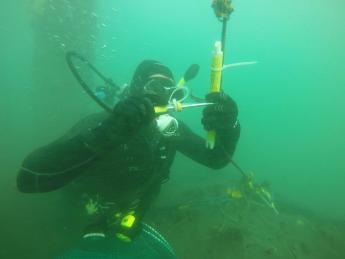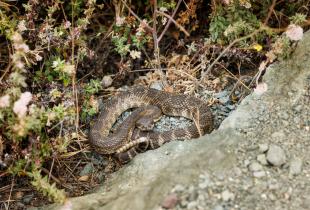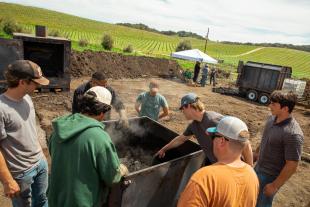Morro Bay's Eelgrass Beds Nearly Disappeared. New Study Helps Explain Why Recovery is Slow

Water-quality conditions in some parts of Morro Bay estuary may be the key factor preventing eelgrass recovery after a recent decline, according to a new Cal Poly study and published in the journal Estuarine, Coastal, and Shelf Science.
“The study shows that in many parts of the bay, environmental conditions likely limit eelgrass growth,” said ecologist Jennifer O’Leary, who started investigating the eelgrass collapse as a California Sea Grant extension specialist based at Cal Poly. (O’Leary is now Africa Oceans strategy director with The Nature Conservancy).
Although researchers cannot yet pinpoint the cause of the initial eelgrass collapse, the study results could help inform efforts to restore eelgrass in the bay by highlighting areas where restoration efforts could be successful.
“Eelgrass is important,” O’Leary said, “because it supports a range of marine life. It’s like the trees in a forest — these underwater plants provide food, structure and shelter to many of the animals that live in the bay.”
Eelgrass is a flowering underwater plant — not a seaweed or an algae — with quarter-inch wide leaves that can grow up to three feet in length. Eelgrass beds are always completely submerged, and their roots anchor the grass to sandy or muddy bottoms.
In recent years Morro Bay’s iconic eelgrass beds experienced a massive die-off, declining more than 90 percent since 2007. Efforts to restore the eelgrass have failed in many parts of the bay, and eelgrass is now only found close to the mouth of the bay and sporadically in other regions.
Local, state and federal partners, including the Morro Bay National Estuary Program (MBNEP), connected with an interdisciplinary team of scientists at Cal Poly to explore the problem. The MBNEP has tracked eelgrass health since the early 2000s and serves as a nexus in the community for the monitoring, restoration, and research surrounding eelgrass.
“Eelgrass is a critical component of a healthy, functioning Morro Bay ecosystem,” said Lexie Bell, MBNEP executive director. “One of the Morro Bay National Estuary Program’s highest priorities is to address eelgrass loss through monitoring, restoration and research. The efforts under the Sea Grant project will be invaluable in discerning reasons for the loss and helping determine the best way forward as we work to protect and restore this crucial habitat.”
Led by Ryan Walter, physical oceanographer and physics professor at Cal Poly, along with O’Leary and Edwin Rainville, Walter’s undergraduate student and a mechanical engineering major from Colorado, the study set out to understand how the movement and existing water quality conditions in different parts of the bay affect eelgrass survival. The team set up oceanographic underwater mooring stations to measure a variety of water quality indicators at different sites in the bay in the summer of 2016. They also tracked down and analyzed hydrology, weather, dredging activity and eelgrass data back to the 1980s to gain a context of the eelgrass ecosystem.
The study shows that in areas where eelgrass disappeared and had not returned — particularly in the southern or back part of the bay — water conditions were dominated by a combination of higher water temperatures and salinity, lower oxygen levels, high turbidity that limits light availability, and limited flushing, where water gets “trapped” for longer periods of time. Previous research has shown that all of these factors can be stressors for eelgrass; together, they may prevent eelgrass from bouncing back.
Close to the mouth of the bay, where ocean tides regularly refresh this region with relatively cool, clear and more oxygenated water, the researchers found that eelgrass has persisted, and recent restoration efforts with the MBNEP were successful.
Researchers are still working to establish the cause of the initial decline. The study results support the idea that sediment changes in the bay — driven by some combination of dredging, heavy precipitation and sediment loading events, followed by drought years — may have contributed to the decline, a hypothesis that Walter and others are exploring.
The new study also highlights the need for more research and monitoring of similar estuaries — both in California and beyond — to establish baselines to better assess drivers of ecosystem collapse when they occur. While there were no comprehensive measurements prior to the decline, current monitoring in the bay is supported by Walter’s grant from the Central and Northern California Coastal Ocean Observing System (for a near-real time view of measurements, visit: https://www.cencoos.org/data/shore/morro).
“Low inflow estuaries like Morro Bay may be more vulnerable to sudden ecosystem changes like the eelgrass collapse we observed here,” says Walter.




